‘If I had 200, I could sell them today’: How oodles became Brisbane’s most popular dog
These dogs are now so much more popular than purebred dogs that people are willing to pay top dollar.
QWeekend
Don't miss out on the headlines from QWeekend. Followed categories will be added to My News.
There are groodles and spoodles, moodles, cavoodles, labradoodles, Aussiedoodles, schnoodles, bernedoodles, sheepadoodles and shoodles.
Oodle dogs – the seemingly endless variety of poodle crossbreeds – have steadily been increasing in popularity in recent years.
Then COVID-19 isolation rules and the rise in numbers of people working from home led to a massive spike in demand for all pets, seemingly especially oodles.
Breeders of the pets are reporting a huge surge in demand for puppies, with hundreds of people prepared to pay eye-watering prices for the “designer’’ dog of their dreams.
Pandemic price tags at interstate kennels have reached up to $8000 for cavoodles and groodles while in Queensland, Diamond Valley Kennels in the Sunshine Coast hinterland, has people begging to pay $4500 for spoodles (cocker spaniel poodle cross) and cavoodles (King Charles cavalier poodle cross) with a prized “ruby red” litter of spoodles recently fetching $5000 each.
How many pets your QLD suburb adopted
Top 100 cutest dogs competition
Diamond Valley Kennels owner Lisa Howlett says her operation, with 32 breeding dogs, is the state’s biggest kennel supplying cavoodles and spoodles and she simply can’t keep up with an insatiable demand for the dogs.
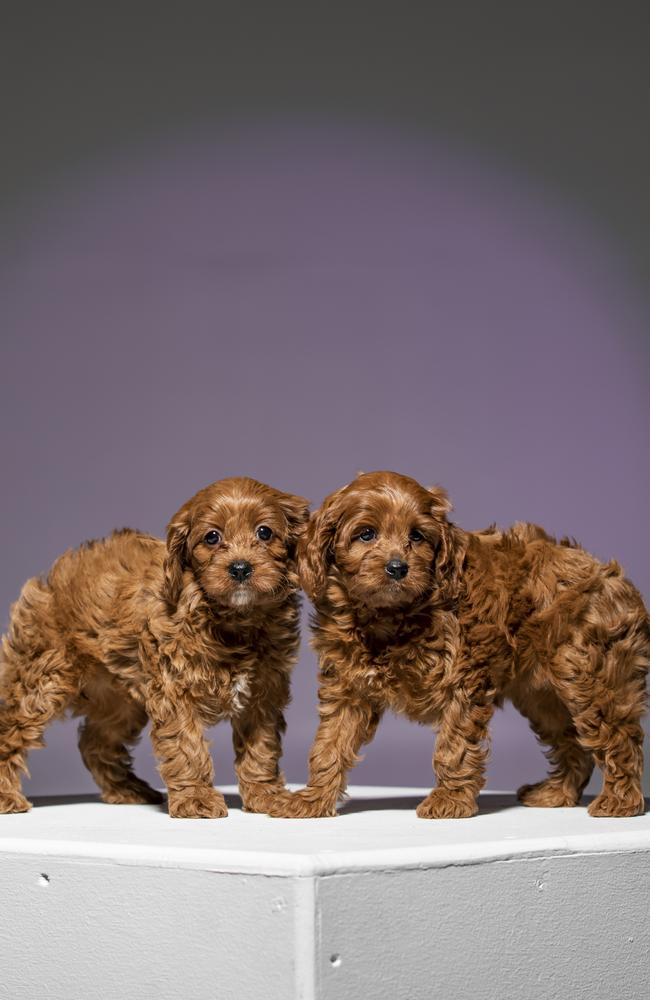
At the peak of demand this year, there were 635 people on her waiting list for puppies. She also breeds shoodles (Shih tzu poodle crosses) and dachshunds.
“Before COVID we would get about 50 emails a day. Then in April, we were getting 180 emails a day from people wanting a puppy right now,’’ Howlett says.
“I just don’t have enough dogs. If I had 200 cavoodle puppies ready to go, I could sell them today. We just sell so many.
“When COVID hit, all prices for all puppies just went through the roof. It really shocked us what people were willing to pay, to be honest.’’
Howlett, 42, has been breeding dogs for 20 years, with it starting out as a side income to her former beauty business at Mooloolah.
However, as demand for the oodles steadily increased, she moved into dog breeding full time, launching her current business four years ago.
Aside from local sales, Howlett sends puppies all over Australia as well as some internationally. She has sent eight dogs to Singapore since 2017 and two spoodle puppies from the same litter to Japan in 2019.
“The import fees are horrendous,” Howlett says. “But some people don’t care how much it costs to get them there.
“The desire for these dogs isn’t going away any time soon.”
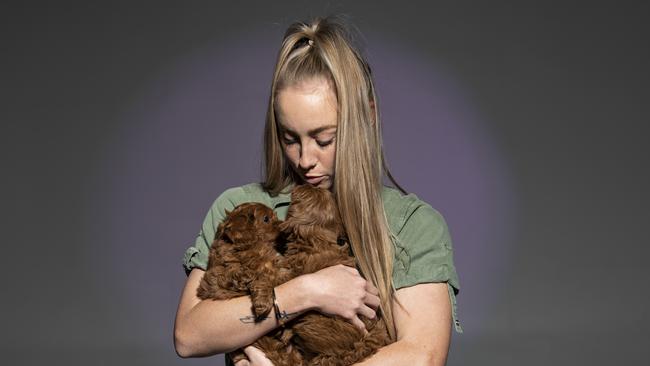
Dogs are Australia’s favourite pet with about 40 per cent of Australian households including at least one dog. A national 2019 pet report estimated that’s 5.1 million dogs outnumbering the nation’s 3.8 million cats, 11.3 million fish, 5.6 million birds, 614,000 small mammals, 364,000 reptiles and 1.8 million other pets. The report, Pets in Australia: a survey of pets and people, was compiled by Animal Medicines Australia, the peak body representing leading Australian animal health companies.
It found the popularity of pure-breed dogs has declined since 2016 – from 52 per cent of all dogs to 40 per cent.
This is offset by the rising popularity of mixed-breed dogs (up 6 per cent to 46 per cent).
Designer breeds – deliberate pairing of certain breeds – now account for 14 per cent of all dogs (up from 8 per cent in 2016).
The most popular designer breeds are malshi (Maltese crossed with Shih tzu), followed by the oodles – several varieties of poodle crosses popular for their low-shedding, low allergenic coats: cavoodles, moodles or malitpoos (Maltese), labradoodles (labrador retriever), spoodles or cockapoos (cocker spaniel), and groodles (golden retriever).
The AMA report found designer dog breeds are more likely to be smaller, with 55 per cent weighing less than 10kg.
Designer breeds are also more likely than other dogs to be allowed to roam freely indoors and outdoors, are more likely to be microchipped, and to have had insurance claims for diagnostic tests that suggest a “humanised, preventive approach to medical care among their owners”.
The report also shows pets are stepping up the pecking order, with many pet owners adopting “pet parenting” behaviours that mimic traditional parent-child relationships. More than 60 per cent of dog and cat owners refer to their pet as a member of the family (their “fur babies”), around half allow their pets to share their beds, and more than 25 per cent take their pets on holidays or road trips.
Madison Kendall, 31, of Hawthorne, in Brisbane’s inner east, specifically researched oodle varieties when she and husband Rowan wanted a dog to join their family.
The couple, who are both lawyers, decided upon a poodle and Bernese mountain dog cross – a bernedoodle – they named Annie.
Kendall, who grew up with a purebred poodle, wanted a dog with a low-shedding, low allergenic coat, while Rowan, 29, a country lad who grew up with working dogs, wanted a breed big and energetic enough to be considered a “real dog”. The bernedoodle was their perfect mix.
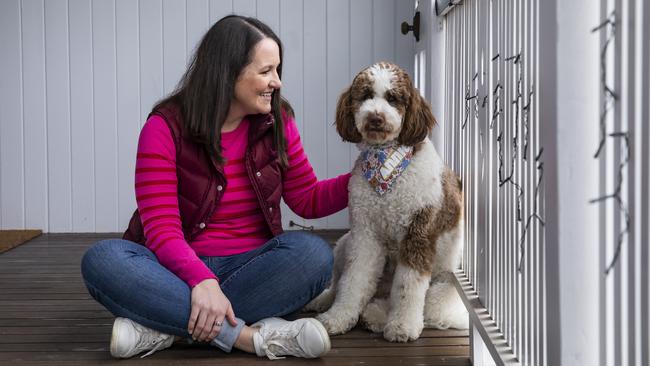
The couple, who are expecting their first baby early next year, paid $3500 for Annie and say she’s been worth every cent.
“Oodles are everywhere. It’s almost like there’s no dog they haven’t crossed a poodle with,” Kendall says.
“I love them because the hypo-allergenic, non-shedding part is wonderful and I’ve always loved the nature of a poodle. They are very smart and therefore easy to train.
“I see lots and lots of oodles. I get lots of questions about what sort of oodle Annie is because she is about the size of a labradoodle but her colouring is different.
“My mum now has a cavoodle, my very good friend also has a cavoodle and two of my friends just got spoodles … we know a lot of oodles.”
Kendall fully admits Annie is treated as well as any human inhabitant of their household, even making it onto the family Christmas card photo. She also attends doggie daycare while the couple are at work (“which is exorbitantly expensive”), she had a birthday party with bespoke cake, she wears handmade bandannas, and receives a monthly mail order subscription box of treats and toys. She also has her own Instagram account (annie.bone.the.bernedoodle).
“Annie is treated like a member of the family and gets included in all activities we do (to the extent they are dog friendly),” Kendall says.
“We used to live in London and people would take their dogs with them everywhere – into pubs, on the Tube, you name it.
“We’re not quite there in Australia yet but we’re getting closer. Because of Annie, we know so many of our neighbours and broader community … she’s such a talking point, particularly because she’s quite unusual as far as ‘oodles’ go and so friendly.
“I think we’re all seeking those sorts of connections in our busy modern lives and part of the reason why dogs have now become such an integral part of people’s lives.
“Annie brings us so much joy and really has added to our lives and because of all that, we like to spoil her and celebrate her.”
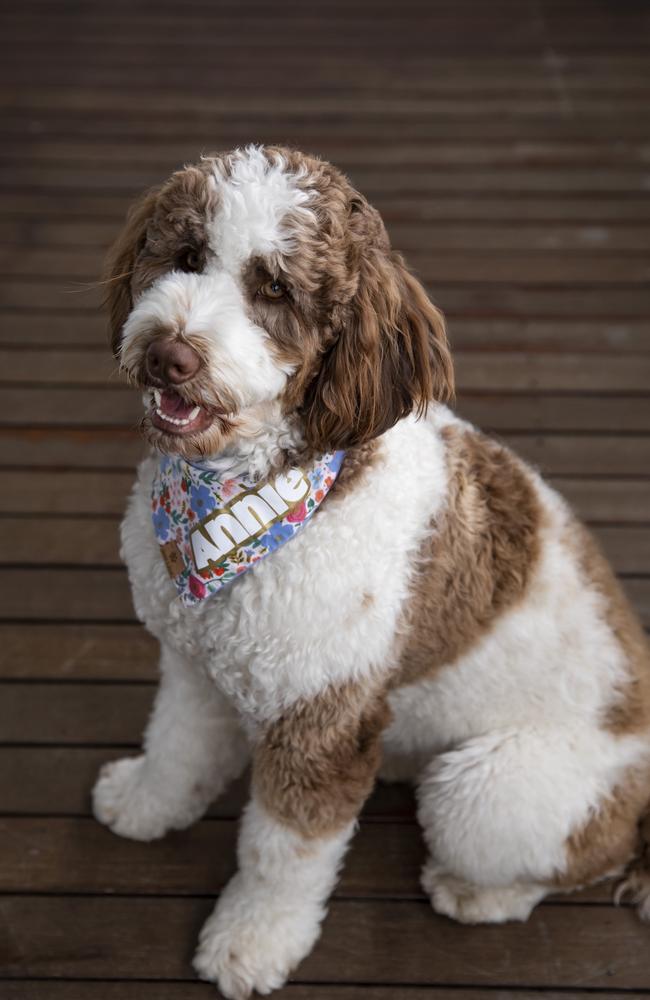
Audrey, the bordoodle – a border collie and poodle cross – has also brought untold joy into the lives of her owners, the Jenkins family of St Lucia.
Linda Jenkins, 46, says her twin daughters Alanah and Sophie, 19, found the breed online and believed a bordoodle would be the perfect match for their family.
Linda Jenkins, a clinical psychologist, who has owned Audrey since September last year, had not heard of the breed before.
“Previously we have had a purebred dog and we had nothing but problems from a health perspective and it was also a really anxious and neurotic dog,’’ she says.
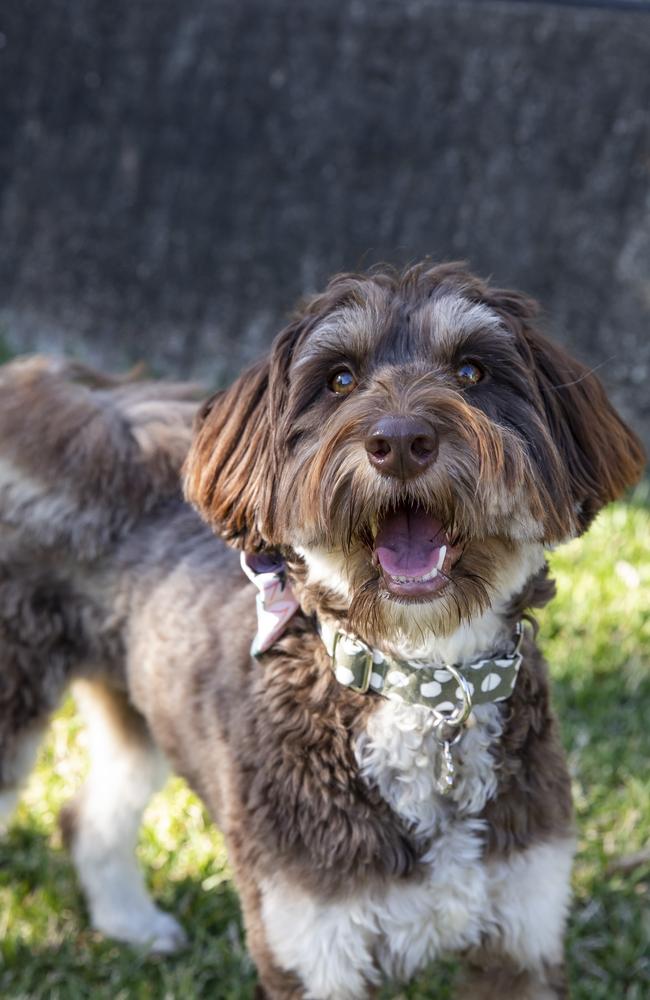
“We’ve also had a bitsa before but with Audrey we knew a bit more about what we were getting. With the mix of the border collie and poodle, we feel we have the best of both worlds. You are getting the intelligence with the bonus of not shedding hair.
“We have two cats as well so having three lots of pet hair in the house was not very appealing.
“We see a lot of oodles … people stop you and ask what type of oodle she is and the next minute they are telling you what oodle they have. It’s pretty funny and I think it’s pretty great that oodles are becoming so popular.
“The cost has been worth it and she has been a really good dog.”
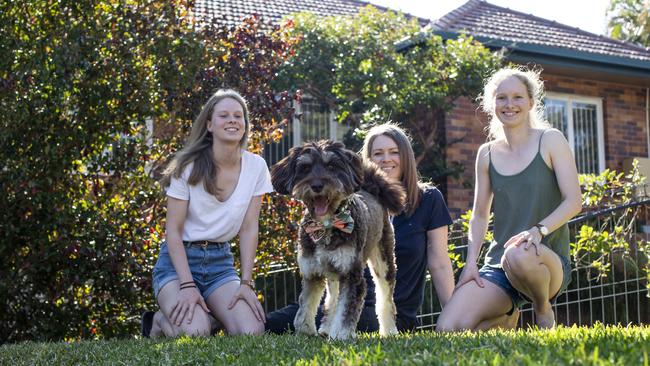
Jenkins is so impressed with Audrey’s temperament that she is considering introducing her to clients in her psychology practice.
“A lot of the oodle dogs are suitable to become therapy dogs,” she says.
“They have good temperament and I can see the benefit of having a dog like her, being a calming influence on clients.”
The first labradoodle is believed to be an Australian dog.
Back in 1989, Sultan, the labradoodle, was bred as a non-shedding guide dog alternative to a labrador by Royal Guide Dogs Association of Australia (now Guide Dogs Victoria) breeding manager Wally Conron.
Conron had been asked for help by a blind woman, Patricia Blum, who lived in Hawaii and whose husband was allergic to long-haired dogs.
Conron thought a standard poodle would be a suitable alternative but after trialling 33 different standard poodles, he concluded the breed did not have the right temperament to be a successful guide dog.
He decided to try a new crossbreed that had the working ability of the labrador and the coat of the poodle – and the labradoodle was born.
However, Conron has since lamented his part in the popularity of oodles and the breeders who “have jumped on the bandwagon” and “breed these dogs and sell them for big bucks”.
Speaking on an ABC radio science report last year, he was concerned about the quality of the breeding process.
“I opened a Pandora’s box and released a Frankenstein’s monster,” he said.
“When I’m out and I see these labradoodles I can’t help myself … I look at it thinking, ‘Does it have hip dysplasia, has it got elbow problems, any other problems I can see?’’’
No breed of dog comes with a guarantee of good health and animal geneticist Professor Claire Wade, 56, from the University of Sydney, says it’s a case of buyer beware.
Wade, who specialises in dog genetics, says prospective oodle owners should thoroughly research the breeder.
“It’s been quite astonishing how popular oodles have become over the past 10 years,’’ she says.
“People sometimes think purebred dogs are unhealthy in some way and that cross-bred dogs are healthier. But it’s really about having a breeder who does the right thing and acts in an ethical way. Cross breeding is not a panacea for having a healthy dog. “There’s a misconception that oodles are all breed A crossed with breed B - like a (King Charles) cavalier mother and a poodle father. But that’s not always the case.
“Sometimes they will have a cavoodle mother and a cavoodle father. Sometimes, if the breeder is not a good breeder, the mother and the father might be close relatives.
“So do your research on the dog’s parents ... usually if the parents are two different breeds, you are pretty safe.’’
Wade suggests looking for a breeder who is
a member of a professional organization and who does thorough health and genetic testing and, in turn, uses the information to make sure the results are compatible between the parents. She also recommends visiting the breeder in person.
Oodles of all kinds have now exploded in popularity. Australian Facebook group Moodles, Poodles, Groodles, Cavoodles and all other Oodles has more than 23,000 members while a Brisbane and Sunshine Coast oodle play date group has 2000 members.
Chris Koupparis, administrator of the Oodle Owners Australia Facebook page, started the group in August 2019 and now has more than 7500 “oodlers”.
Based in Melbourne, Koupparis, 49, is a business development manager and owns “full sister” cavoodles Evie May and Mia Rose (Instagram evie_mia_k_cavoodles) with his wife Sharon.

He says he grew up scared of dogs but now says his oodles have changed his life.
“It seems like oodles are everywhere,’’ he says. “They’re at the dog parks, out on walks, driving around with their owners in cars, having a coffee at the cafes with mum and dad.
“Generally oodles are friendly, loving, playful, intelligent and family friendly.
“We often catch up with other oodle owners to let our babies run around and have a play together. They play beautifully; there’s never an issue, they all just get along.
“I love my dogs and I treat them like they are human. They actually eat better than me, they are so spoiled.
“They are just the best and I cannot imagine my life without them.”

Australian Pet Dog Trainers Association president Louise Ginman is supervisor of carnivores at Taronga Park Zoo in Sydney and has run her own puppy training business since 2013.
She has noticed a steep increase in the number of oodle puppies in her classes.
“When I started, there was at least one oodle in every class but now there are three, four, sometimes the entire class is oodles in one form or another. They are highly popular,” she says.
“Personally, I don’t think they are easier to train. Just like any breed, there can be behavioural problems.
“A danger is to buy these dogs sight unseen because not all breeders are created equal.
“They are also relatively high maintenance. You have to take them to the groomer and get their face clipped and brush them regularly.”
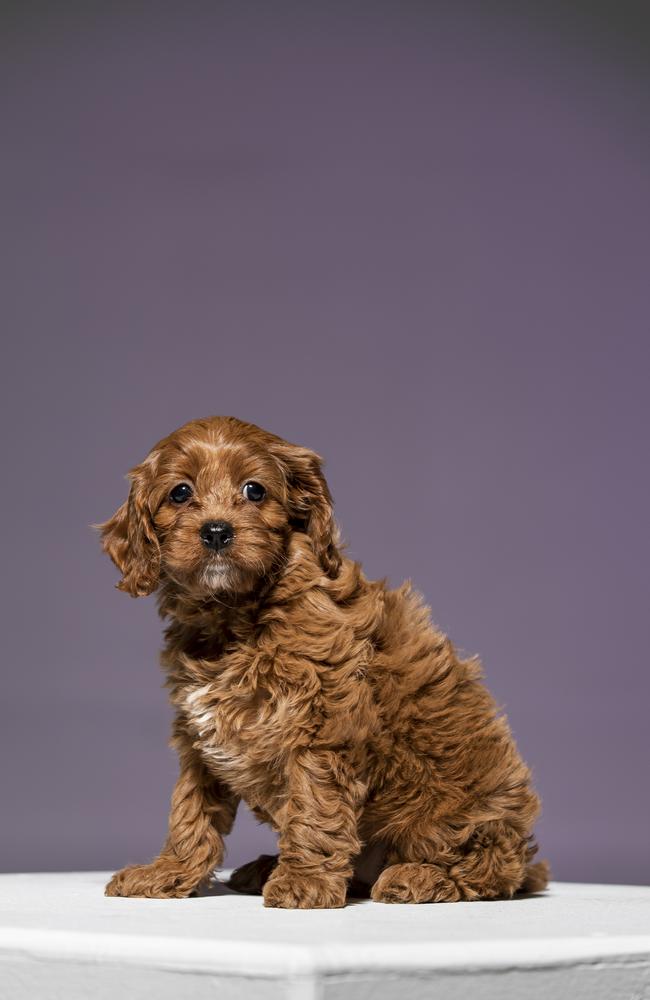
Ginman says she has seen other breeds of dogs go through popularity phases before such as Siberian huskies, dalmatians and French bulldogs but “not to this extent of the oodle”.
“It has sustained over time and, if anything, it is increasing,” she says.
“There are an awful lot of oodles out there, I notice it walking around my neighbourhood. The varieties of oodles are never ending and they aren’t going away anytime soon.”
Australian Association of Pet Dog Breeders president Tracee Rushton says the huge variety of oodle breeds means there is “a fit for every family”.
Rushton, 58, operates Green Gate Kennels in central western NSW and breeds moodles (Maltese poodle cross) and schnoodles (schnauzer poodle cross).
“Poodles come in different sizes – toy, miniature and standard – so you can have a poodle cross the same size as a golden retriever right down to a small lapdog,” she says. “There’s an oodle cross to fit every family. They are also excellent companions for people with anxiety or very calming for kids with ADHD.
“We regularly get approached by people looking for poodle crosses as companion or therapy dogs and for children.
“In my experience, for example, the moodles are very quiet … kids can pick them up, they can do anything and these dogs don’t have a nasty bone in their body.
“Other dog breeds just don’t have the same variety … you can cross a poodle with just about anything.”
Howlett, with her family – daughter Ashley, 21, son Ben, 16, and husband Michael, 51 – lives on the same site as her dog breeding business.
Her own pets are Macey, a mini cavoodle and a shoodle called Lara. She also has Ally, a golden retriever.
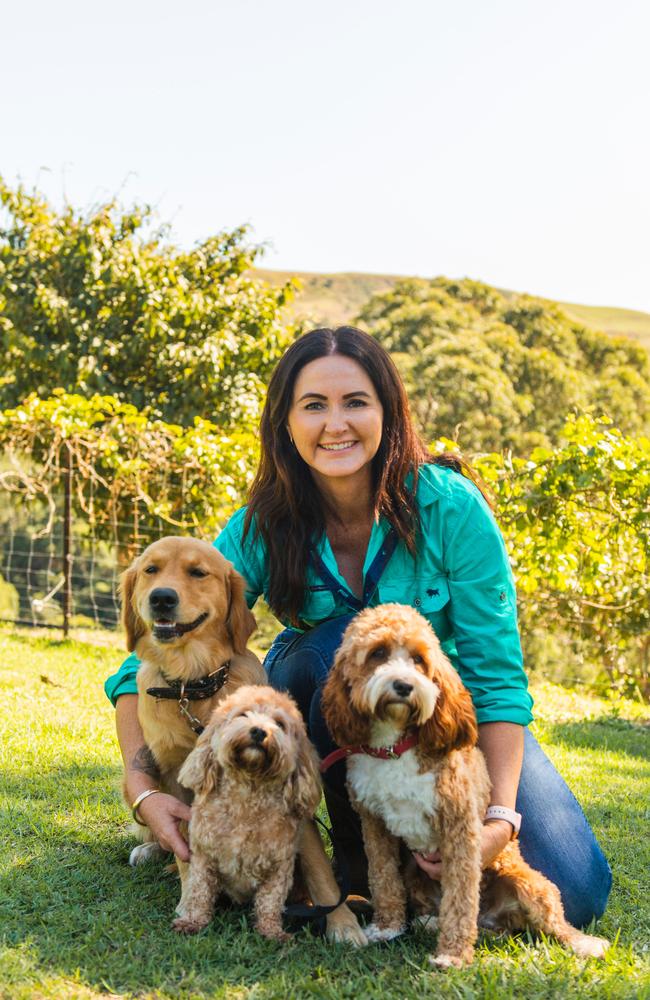
With business booming, Howlett currently has a development application before the local council to relocate to a bigger site on 20ha on Steve Irwin Way in Landsborough.
The business, she says, has taken over her property and she “wants our home back”.
She has also applied to expand her business to include boarding kennel facilities for 200 small to medium-sized dogs, as well as potentially increasing the number of breeding dogs she is allowed to 60.
As a dog breeder, Howlett is not naive to the controversy her business whips up in animal activist circles.
She has been criticised, trolled and attacked for breeding dogs at all.
News of her intention to expand has been met with a frenzy of social media attacks targeting her and her staff.
But Howlett, who says her business is “highly scrutinised and checked” says she is doing her best to change a perception that dog breeders operate with questionable ethics.
She welcomes prospective puppy owners to visit the kennels (with an appointment).
She says all her breeding dogs are rehomed between five and six years of age and females are limited to having four litters in their lifetime.
“I wanted to change the way things were done in regard to breeding and my main thing was opening to the public.
“I was sick of the stigma of people thinking all breeders are ethically bad,” she says.
“I want people to be more comfortable in coming out and having a look where the puppies are raised and sitting down and playing with the puppies before choosing one.
“Fifteen years ago, a dog was a dog. Now they are part of the family and treated as people’s children.
“A puppy is a new family member and people want that bond and connection.
“These dogs really are a great-natured
family pet and I don’t see anything wrong with providing dogs that become a treasured part
of families.”

